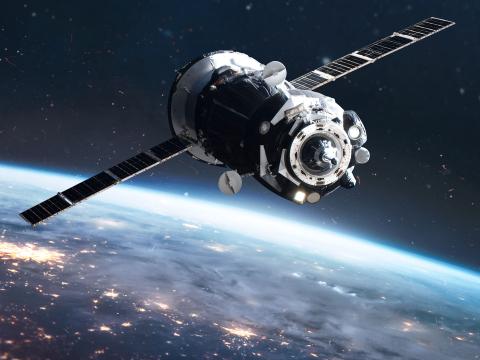Not Your Grandfather's HF
Advanced long-distance communication solutions are needed for the military of the future, especially for operations in contested environments. Innovative high frequency solutions offer communication over long distances in real time and provide an alternative to satellite communications. The U.S. military and industry are working to harness wideband high frequency technologies, which can offer higher data rates on a single high frequency communications channel.
To the Air Force, which has long relied on crucial high frequency (HF) communications for aviation, a move to next-generation solutions is necessary, and is something the service is focusing on, said Brig. Gen. Bradley Pyburn, USAF, director, Cyberspace Operations and Warfighter Communications, Air Force Headquarters.
“Think about Joint All Domain Command and Control and how are we going to have global, survivable, resilient communications that are going to enable the Joint fight,” Gen. Pyburn said at the recent AFCEA Alamo Chapter ACE event on November 20. “I think it starts with HF and our ability to modernize our global HF enterprise to take advantage of industry advancements in algorithms and efficient use of the spectrum.”
In particular, the service is pushing toward digital wideband HF “and how that's going to work in a contested environment,” the general noted. “That's one of the tangible things that we're trying to do.”
The industry also is implementing digital wideband HF solutions. Collins Aerospace began demonstrating a wideband HF air-to-ground data transfer application as part of an effort with the service's Air Mobility Command in 2016. At that time, the next generation HF system moved data files of 1 megabyte from air-to-ground across an HF data link of 2,000 miles.
This fall, the Air Force selected the company to upgrade its fleet of U-2 aircraft with lightweight HF radios, using the HF-9087D version. It is a solid-state digital radio for both rotary and fixed-wing aircraft applications. Using the system on the U-2—a high altitude aircraft that performs key intelligence, surveillance and reconnaissance for the Air Force—enables the secure transfer of command and control data in real time, along with voice communications beyond line of sight, according to Collins.
The capability provides an important alternative to satellite communications, explained Ron Broden, business development manager for Airborne HF at Collins.
“With all of the threats that are going out there to try to jam people and break up communications, HF, which is high frequency communications, is becoming more important as a kind of a backbone for communications, because it is more resilient,” he said.
HF, which is really at the low end of the spectrum, between 2 and 30 megahertz, was first used by radio innovators in the 1930s. “At the time it was high frequency,” Broden said. “The early pioneers used that part of the spectrum to transmit across long distances. That’s how some of the first Transatlantic messages were sent. And back in the day, before satellites, HF was really the only way to have really long-distance radio communications. So, HF was of very important strategic importance in World War II and it was used heavily, … especially with bombers.”
The only problem with HF in the past was that it was not really good for data, he continued. Now with the digital application of the HF radio—in addition to analog voice—and other improvements to the receiver-transmitters, the venerable HF is again a solid option. “The new radio does have a data modem, and it does have wider channels that offers the ability to go over 19 kilobits per second,” he noted. “That's something that they've never had in the U-2, that data capability.”
Part of employing that HF capability means figuring out how the service can best use it. “Well, that's the interesting part because they've never had the capability before and now they get to figure out what they want,” Broden said. “And realistically if you look at aircraft operations, talking about data, there's kind of unlimited need to get data on and off of these airplanes.”
And while HF communications may not yet be practical for very large, high-speed type of data transfers, it could be used for other priorities, such as command and control, texting, smaller photos or files, or weather updates. “That kind of stuff can be sent over HF now and it doesn't tie up your SATCOM,” Broden added. “It gives the Air Force the chance to make more use of their communication tools.”
Collins is working closely with Lockheed Martin to do the HF integration work on the U-2, Broden clarified.
Meanwhile, Thales is pursuing its so-called HF XL concept, an HF cognitive radio capability that dynamically adapts to channel variations and spectrum congestion, and greatly increases capacity.
“This new wideband HF technology will provide the armed forces with robust, dependable data communications offering eight times more bandwidth than current HF systems,” a company spokesman said in a statement. “It will guarantee high-quality connectivity at any point on the planet, with improved resilience to interference, paving the way for new user services.”
The HF cognitive radio aspect of the company’s solution offers “a smart way to escape narrowband jammers,” a key capability in contested environments, the company indicated. The technology maintains the link to HF over various channel conditions, while supporting Internet Protocol (IP) services, high definition picture and video data.
The system will be interoperable with the current generation of HF radios. The company began with naval-based testing this year, aims for first delivery next year and field testing in 2022.






Comment
interest in the use of hf
interest in the use of hf radio around the world. Innovation and utilities
Digital modes in HF for
Digital modes in HF for strike groups and deployed units is a great idea and if the HAM radio community is invited to participate, may gain great deal of insight today. I am not so naive to think that is not already happening, just mentioning it. As a HAM myself, in Japan I used my personal HF playing around and was pleased with PSK31 and other digital modes. Software these days decipher a lot of digital modes and CW.
There are some amazing new antenna's coming out too.
Great way to go with HF...as
Great way to go with HF...as a licensed HAM , MK20 Mooney Airplane driver and former AF officer I would like to assist in any develop of this technology for airborne applications and national defense.
Comments